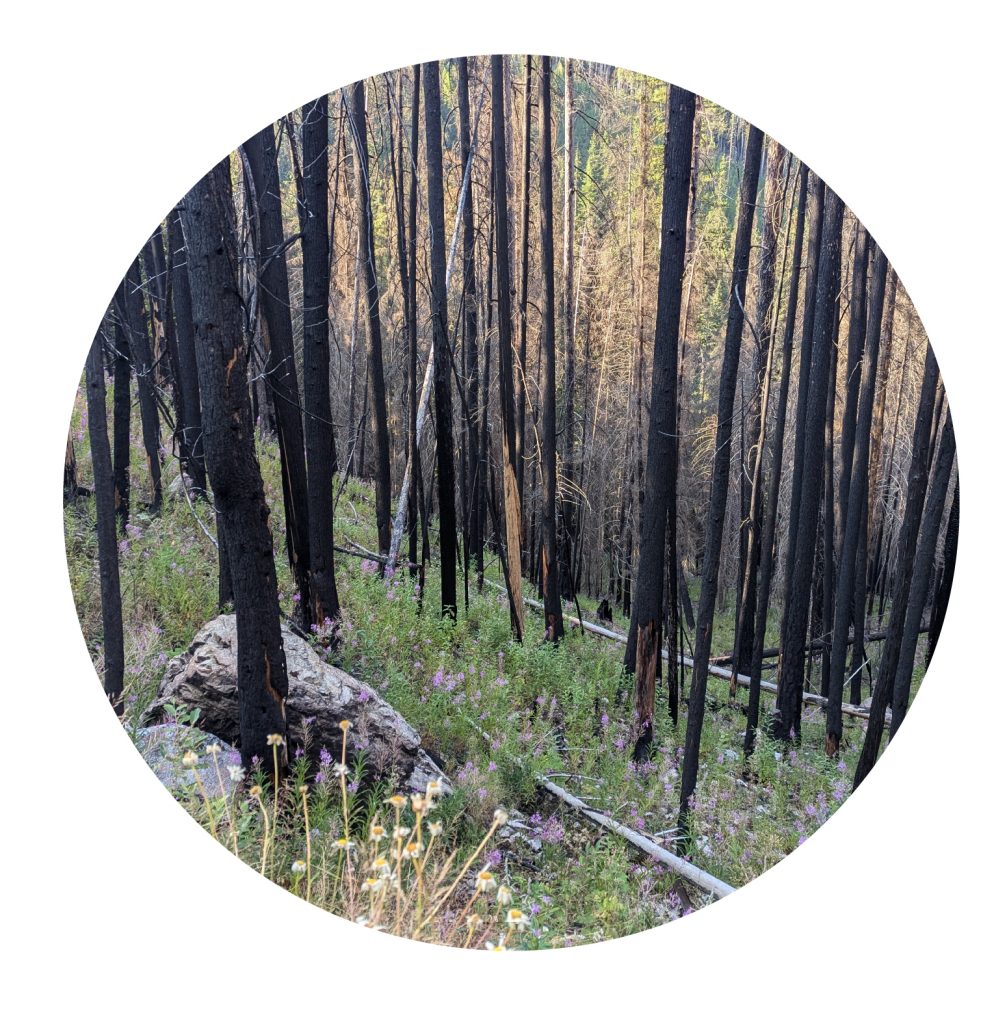Fire has played a significant role in shaping many of the forests throughout British Columbia. It serves many benefits to the forest ecosystems, including initiating succession, creating diverse habitat, influencing species composition and changing the distribution of insects and disease ¹. Indigenous forest management, included burning, which was used for vegetation management and promoted the growth of important food and medicine plants ². In the late 19th century Indigenous burning was outlawed, which contributed to over a century of fire suppression in British Columbia’s forests ². Climate change and the suppression of fire has impacted the scale, intensity, and severity of current wildfires. In 2021, 45% of public land was classified as being at extreme threat of wildlife³. Forest management is now focused on how to minimize the social and economic impacts of fire, with maximizing the ecological benefits ¹.
2021 Trozzo Creek Wildfire Photo by Geoffrey Campbell
Management Strategies
The following are recommended management strategies to help mitigate the intensity of fire in forested areas
- Increase the use of cultural and prescribed burning – a return of Indigenous land stewardship⁴
- Promotion of understory plants – increase native plants, which have better water retention and creates more stable soil³
- Leaving large diameter debris in treated forests – leaving large logs (larger than 7 cm in diameter), promotes growth of fungi and functions as a moisture sink during rain
- Creation of light diversity through opening up the canopy – Increases soil moisture with more rainwater reaching the understory, increases plant diversity, and creates space between trees³
- Greater water retention – increases soil moisture (see GRI section )³
- Increase diversity of tree species and age ⁴
Management Strategies Around Structures
Design and maintenance around homes and other structures can be categorized into zones. The zones of protection can differ based on the type of plants and the site.
Source ⁵
Zone 1 – 10 m
- Keep area around structure clear of flammable material
- plant lower ground cover and water deeply to encourage deep roots
- Remove shrubs and vines around mature trees, trim the lower branches of the trees
- Try to plant fire resistant deciduous trees rather than conifers which are more resinous

Photo by Geoffrey Campbell
Zone 2 – 10 -30 m
- Remove vines and shrubs around mature trees (ladder fuel)
- Clear some vegetation between trees
Zone 3 – 30 – 70 m
- Remove ladder fuel around conifers
Plants for Fire Resilient Landscapes
Fire Smart BC has compile a list of Vancouver fire resistant plants and hazardous plants. Using these plant guidelines, can help when planting fire resilient landscapes. ⁶
Features of fire resistant plants
- Moist and supple leaves
- Little dead wood or accumulated dead material
- Open branching habits
- Fewer total branches and leaves
- Slow growing habits, which reduces pruning requirements
- Water-like sap with little or no odour.
- A low amount of sap or resin material
Features of fire prone plants
- Fine, dry, and dead materials such as twigs, needles, and leaves
- Loose and papery bark
- Stems, branches, or leaves that contain volatile waxes, terpenes, or oils
- Aromatic leaves that produce a strong odour when crushed
- Gummy, resinous sap with a strong odour
2024 Ponderosa Fire Photo by Mikhayla Roht
Plants in Fire Ecologies
There are several plants found throughout British Columbia that have fire-adaption traits which allow them to survive or thrive in fire.
Thick bark
- Protects the tree from heat and does not catch fire easily ⁷. Trees with thick bark include Pinus ponderosa (Ponderosa pine) and Pseudostuga menziesii (Douglas-fir) ⁷.
Resprouting
- Plants with the ability to resprout after fire have buds below ground such as rhizomes or root crowns ⁷. Examples of plants that are able to regenerate after fire include Acer macrophyllum (Bigleaf maple) and Populus tremuloides (quaking aspen)⁷.
Serotinous Cones
- These cones are protected by a waxy resign which requires fire for the seeds to release. Pinus contorta var. latifolia (Lodgepole pine), have serotinous cones and often seed after fire ⁸.
1. Hirsch, Kelvin & Kafka, Victor & Tymstra, Cordy & McAlpine, Rob & Hawkes, Brad & Stegehuis, Herman & Quintilio, Sherra & Gauthier, Sylvie & Peck, Karl. (2001). Fire-smart forest management: A pragmatic approach to sustainable forest management in fire-dominated ecosystems. The Forestry Chronicle. 77. 357-363. 10.5558/tfc77357
2. Dickson‐Hoyle, S., Ignace, R. E., Ignace, M. B., Hagerman, S. M., Daniels, L. D., & Copes‐Gerbitz, K. (2021). Walking on two legs: A pathway of indigenous restoration and reconciliation in fire‐adapted landscapes. Restoration Ecology, 30(4). doi:10.1111/rec.13566
3. BCFPB. (2023). Forest and fire management in BC: Toward landscape resilience
4. Graham, J., & Riccitelli, C. (2022). Galiano Conservancy. Towards a more Ecological Version of FireSmart for Galiano Island
5. Reed, S. (2010). Energy-wise Landscape Design – A New Approach for your Home and Garden
6. FireSmart BC. (2023). Fire-resistant plants
7. Kuhlmann, E. (2015). WNPS. Plant adaptations and fire.
8. Natural Resources Canada(2024). Fire ecology.
